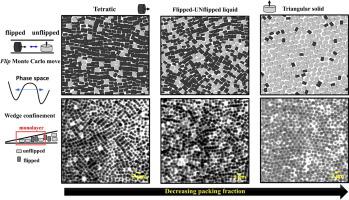Journal of Colloid and Interface Science ( IF 9.9 ) Pub Date : 2021-09-15 , DOI: 10.1016/j.jcis.2021.09.073 B P Prajwal 1 , Jen-Yu Huang 1 , Meera Ramaswamy 2 , Abraham D Stroock 1 , Tobias Hanrath 1 , Itai Cohen 2 , Fernando A Escobedo 1

|
The entropy-driven monolayer assembly of hexagonal prisms and cylinders was studied under hard slit confinement. At the conditions investigated, the particles have two distinct and dynamically disconnected rotational states: unflipped and flipped, depending on whether their circular/hexagonal face is parallel or perpendicular to the wall plane. Importantly, these two rotational states cast distinct projection areas over the wall plane that favor either hexagonal or tetragonal packing. Monte Carlo simulations revealed a re-entrant melting transition where an intervening disordered Flipped-Unflipped (FUN) phase is sandwiched between a fourfold tetratic phase at high concentrations and a sixfold triangular solid at intermediate concentrations. The FUN phase contains a mixture of flipped and unflipped particles and is translationally and orientationally disordered. Complementary experiments were conducted with photolithographically fabricated cylindrical microparticles confined in a wedge cell. Both simulations and experiments show the formation of phases with comparable fraction of flipped particles and structure, i.e., the FUN phase, triangular solid, and tetratic phase, indicating that both approaches sample analogous basins of particle-orientation phase-space. The phase behavior of hexagonal prisms in a soft-repulsive wall model was also investigated to exemplify how tunable particle–wall interactions can provide an experimentally viable strategy to dynamically bridge the flipped and unflipped states.
中文翻译:

重入跃迁作为六棱柱和圆柱的受限单层中破碎遍历性的桥梁
在硬狭缝限制下研究了熵驱动的六棱柱和圆柱体的单层组装。在研究的条件下,粒子具有两种不同且动态断开的旋转状态:未翻转和翻转,具体取决于它们的圆形/六边形面是平行还是垂直于壁面。重要的是,这两种旋转状态在壁平面上投射出不同的投影区域,有利于六边形或四边形堆积。蒙特卡罗模拟揭示了一种重入熔化转变,其中一个无序的翻转-未翻转 (FUN) 相夹在高浓度的四重四方相和中等浓度的六重三角形固体之间。FUN 相包含翻转和未翻转粒子的混合物,并且在平移和方向上是无序的。补充实验是用光刻制造的圆柱形微粒限制在楔形单元中进行的。模拟和实验都显示了具有相当比例的翻转粒子和结构的相的形成,即 FUN 相、三角固体和四元相,表明这两种方法都接近样本粒子取向相空间的类似盆地。还研究了软排斥壁模型中六边形棱柱的相行为,以举例说明可调粒子 - 壁相互作用如何提供实验上可行的策略来动态桥接翻转和未翻转状态。补充实验是用光刻制造的圆柱形微粒限制在楔形单元中进行的。模拟和实验都显示了具有相当比例的翻转粒子和结构的相的形成,即 FUN 相、三角固体和四元相,表明这两种方法都接近样本粒子取向相空间的类似盆地。还研究了软排斥壁模型中六边形棱柱的相行为,以举例说明可调粒子 - 壁相互作用如何提供实验上可行的策略来动态桥接翻转和未翻转状态。补充实验是用光刻制造的圆柱形微粒限制在楔形单元中进行的。模拟和实验都显示了具有相当比例的翻转粒子和结构的相的形成,即 FUN 相、三角固体和四元相,表明这两种方法都接近样本粒子取向相空间的类似盆地。还研究了软排斥壁模型中六边形棱柱的相行为,以举例说明可调粒子 - 壁相互作用如何提供实验上可行的策略来动态桥接翻转和未翻转状态。三角形固体和四元相,表明两者都接近样品颗粒取向相空间的类似盆地。还研究了软排斥壁模型中六边形棱柱的相行为,以举例说明可调粒子 - 壁相互作用如何提供实验上可行的策略来动态桥接翻转和未翻转状态。三角形固体和四元相,表明两者都接近样品颗粒取向相空间的类似盆地。还研究了软排斥壁模型中六边形棱柱的相行为,以举例说明可调粒子 - 壁相互作用如何提供实验上可行的策略来动态桥接翻转和未翻转状态。



























 京公网安备 11010802027423号
京公网安备 11010802027423号